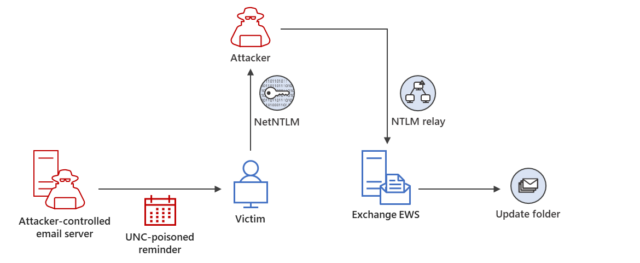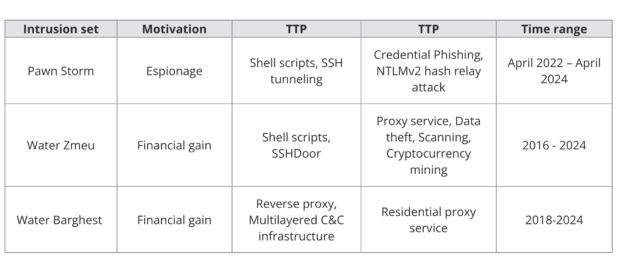
Cybercriminals and spies working for nation-states are surreptitiously coexisting inside compromised name-brand routers as they use the devices to disguise attacks motivated both by financial gain and strategic espionage, researchers said.
In some cases, the coexistence is peaceful, as financially motivated hackers provide spies with access to already compromised routers in exchange for a fee, researchers from security firm Trend Micro reported Wednesday. In other cases, hackers working in nation-state-backed advanced persistent threat groups take control of devices previously hacked by the cybercrime groups. Sometimes the devices are independently compromised multiple times by different groups. The result is a free-for-all inside routers and, to a lesser extent, VPN devices and virtual private servers provided by hosting companies.
“Cybercriminals and Advanced Persistent Threat (APT) actors share a common interest in proxy anonymization layers and Virtual Private Network (VPN) nodes to hide traces of their presence and make detection of malicious activities more difficult,” Trend Micro researchers Feike Hacquebord and Fernando Merces wrote. “This shared interest results in malicious internet traffic blending financial and espionage motives.”
Pawn Storm, a spammer, and a proxy service
A good example is a network made up primarily of EdgeRouter devices sold by manufacturer Ubiquiti. After the FBI discovered it had been infected by a Kremlin-backed group and used as a botnet to camouflage ongoing attacks targeting governments, militaries, and other organizations worldwide, it commenced an operation in January to temporarily disinfect them.
The Russian hackers gained control after the devices were already infected with Moobot, which is botnet malware used by financially motivated threat actors not affiliated with the Russian government. These threat actors installed Moobot after first exploiting publicly known default administrator credentials that hadn’t been removed from the devices by the people who owned them. The Russian hackers—known by a variety of names including Pawn Storm, APT28, Forest Blizzard, Sofacy, and Sednit—then exploited a vulnerability in the Moobot malware and used it to install custom scripts and malware that turned the botnet into a global cyber espionage platform.
The Trend Micro researchers said that Pawn Storm was using the hijacked botnet to proxy (1) logins that used stolen account credentials and (2) attacks that exploited a critical zero-day vulnerability in Microsoft Exchange that went unfixed until March 2023. The zero-day exploits allowed Pawn Storm to obtain the cryptographic hash of users’ Outlook passwords simply by sending them a specially formatted email. Once in possession of the hash, Pawn Storm performed a so-called NTLMv2 hash relay attack that funneled logins to the user accounts through one of the botnet devices. Microsoft provided a diagram of the attack pictured below:

Trend Micro observed the same botnet being used to send spam with pharmaceutical themes that have the hallmarks of what’s known as the Canadian Pharmacy gang. Yet another group installed malware known as Ngioweb on botnet devices. Ngioweb was first found in 2019 running on routers from DLink, Netgear, and other manufacturers, as well as other devices running Linux on top of x86, ARM, and MIPS hardware. The purpose of Ngioweb is to provide proxies individuals can use to route their online activities through a series of regularly changing IP addresses, particularly those located in the US with reputations for trustworthiness. It’s not clear precisely who uses the Ngioweb-powered service.
The Trend Micro researchers wrote:
In the specific case of the compromised Ubiquiti EdgeRouters, we observed that a botnet operator has been installing backdoored SSH servers and a suite of scripts on the compromised devices for years without much attention from the security industry, allowing persistent access. Another threat actor installed the Ngioweb malware that runs only in memory to add the bots to a commercially available residential proxy botnet. Pawn Storm most likely easily brute forced the credentials of the backdoored SSH servers and thus gained access to a pool of EdgeRouter devices they could abuse for various purposes.
The researchers provided the following table, summarizing the botnet-sharing arrangement among Pawn Storm and the two other groups, tracked as Water Zmeu and Water Barghest:

It’s unclear if either of the groups was responsible for installing the previously mentioned Moobot malware that the FBI reported finding on the devices. If not, that would mean routers were independently infected by three financially motivated groups in addition to Pawn Storm, further underscoring the ongoing rush by multiple threat groups to establish secret listening posts inside routers. Trend Micro researchers weren’t available to clarify.
The post went on to report that while the January operation by the FBI put a dent in the infrastructure Pawn Storm depended on, legal constraints prevented the operation from preventing reinfection. What’s more, the botnet also comprised virtual public servers and Raspberry Pi devices that weren’t affected by the FBI action.
“This means that despite the efforts of law enforcement, Pawn Storm still has access to many other compromised assets, including EdgeServers,” the Trend Micro report said. “For example, IP address 32[.]143[.]50[.]222 was used as an SMB reflector around February 8, 2024. The same IP address was used as a proxy in a credential phishing attack on February 6 2024 against various government officials around the world.”
https://arstechnica.com/?p=2021233

